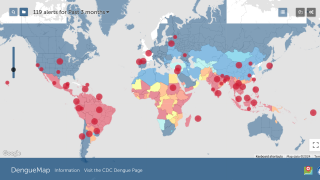Florida Flowers Enable Disease-Carrying Mosquitoes to Flourish

A leading source for the Zika outbreak in 2016 may have been those ornamental flowers in Florida.
A new study has revealed that bromeliad plants contribute to the breeding of the Aedes aegypti mosquito, which can carry infectious diseases such as Zika, dengue, yellow fever and chikungunya.
Bromeliad is the name for a family of plants that is incredibly diverse. There are 2,877 different species of bromeliads.
These flowers are common throughout South Florida and are a popular choice for landscaping projects since they do not require much care.
This University of Miami Miller School of Medicine (UM) study, published in the journal Parasites & Vectors, showed that water retained in the bromeliads' leaf axils becomes breeding sites for the Aedes aegypti, the most dominant species of mosquito in the study's test sites.
The lead study author John Beier, Sc.D., a UM Miller School entomologist, and director of the Division of Environmental and Public Health, urged against destroying the plants.
But, Beier said the new knowledge on the plant's role in mosquito breeding will help tailor mosquito control efforts.
"People should be aware that bromeliads are producing mosquitos so that they can treat the plants," he said in a press release.
Beier added that the dominant presence of the Aedes aegypti mosquito was unexpected since the mosquito did not have as great a presence in bromeliads in prior years.
"The larger problem is with the Aedes aegypti, not the disease," he said.
"Currently, the best defense we have against mosquito-borne illnesses is bite prevention. Take steps to control mosquitoes inside and outside your home, cover up if possible, and use an appropriate insect repellant,” Michelle Beall, PharmD, Clinical Pharmacist Pharmacy Health Services for Brookshire Grocery Company.
“Your local pharmacist or other healthcare providers can help you select the right one for you and your family," continued Beall.
Similar to the sudden Zika outbreak in 2016, researchers said vector-borne diseases are spreading to new areas due to urbanization, human movement, and global warming.
But, according to previous research, the probable vector for these infectious diseases may be humans who travel internationally.
Recently, an international research team used genomic tools to trace the spread of the Zika virus.
This analysis suggests the Zika family tree shows, with a few exceptions, the virus that infected people in Florida, Central America or Mexico descended from a single importation event in Brazil.
The evidence also shows that many locations experienced two waves of Zika infection per year, not just one.
Peaking approximately every 6 months, the researchers analyzed the environmental suitability in each country for the Aedes aegypti mosquitoes that primarily transmit Zika virus to people.
Their findings suggest that conditions ripe for the spread of Zika virus occur at different times of the year, depending on elevation and other factors.
Such as flowers!
UM has been a major partner in research, including mosquito mapping, surveillance, and trapping. This research collaboration was supported by the U.S. Centers for Disease Control and Prevention.
Our Trust Standards: Medical Advisory Committee
- Ornamental bromeliads of Miami-Dade County, Florida are important breeding sites for Aedes aegypti
- General Indoor and Outdoor Bromeliad Care
- UM study confirms that bromeliads contribute to mosquito breeding in Miami
- America’s Zika Family Tree Originated in Brazil
- Prevention and Control Strategies to Counter Zika Virus, a Special Focus on Intervention Approaches against Vector Mosquitoes


























